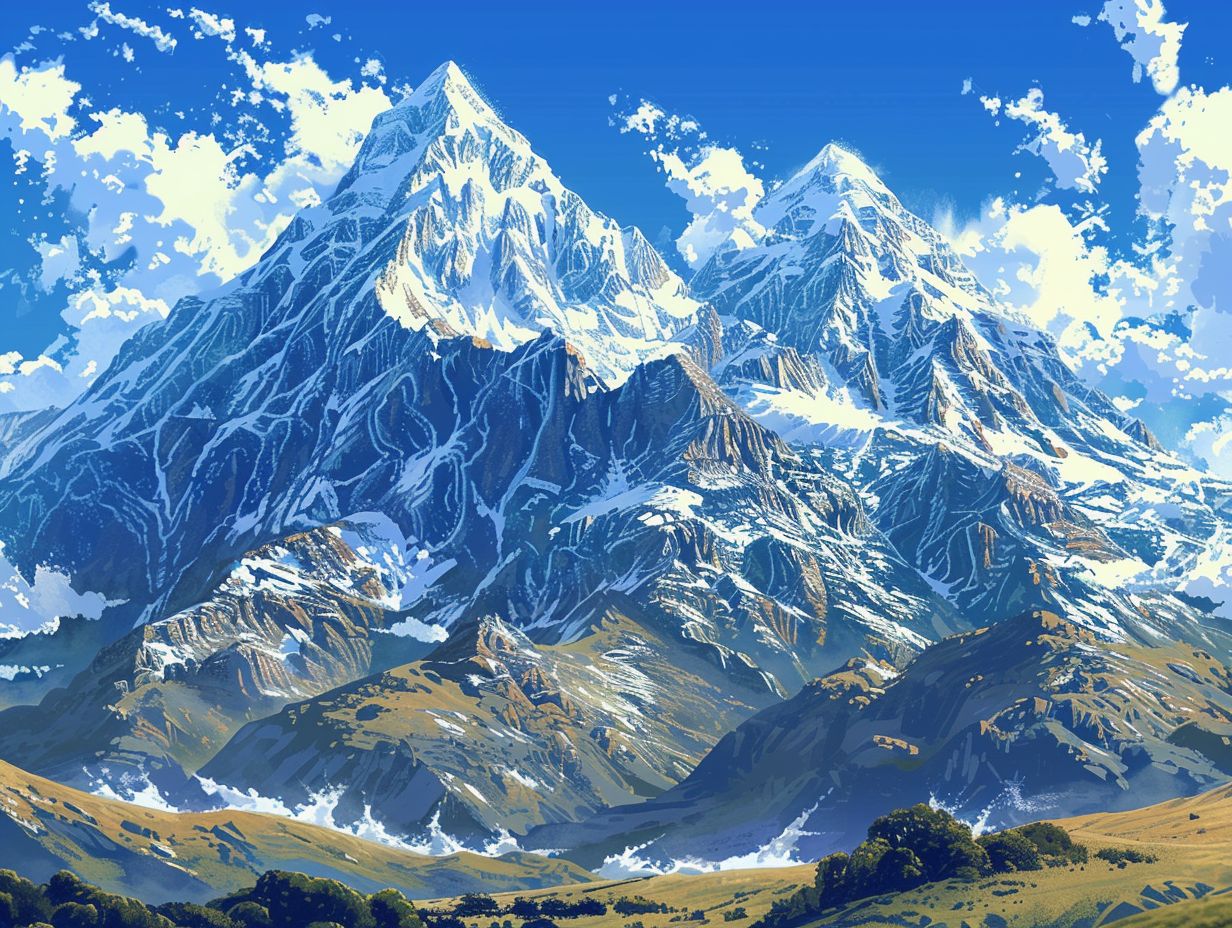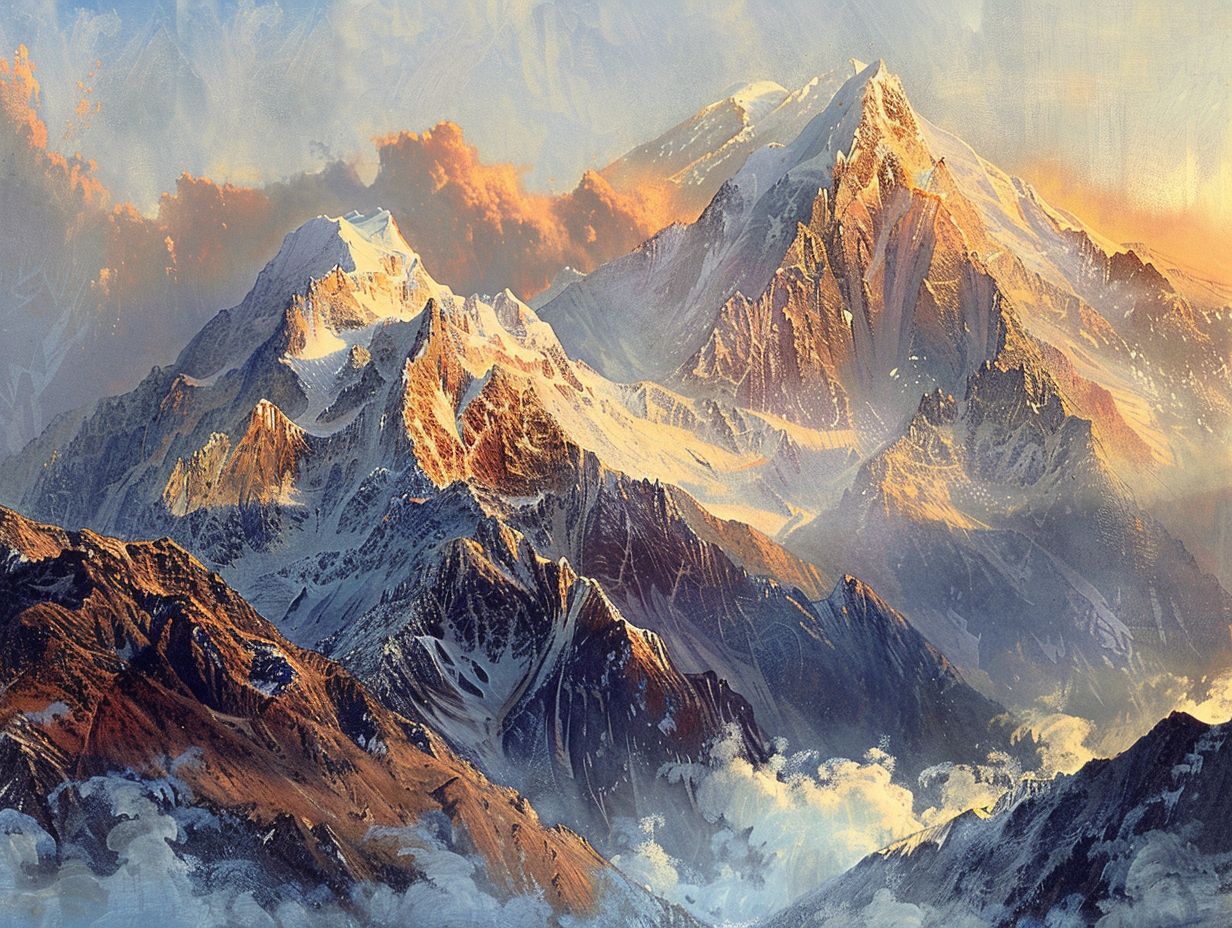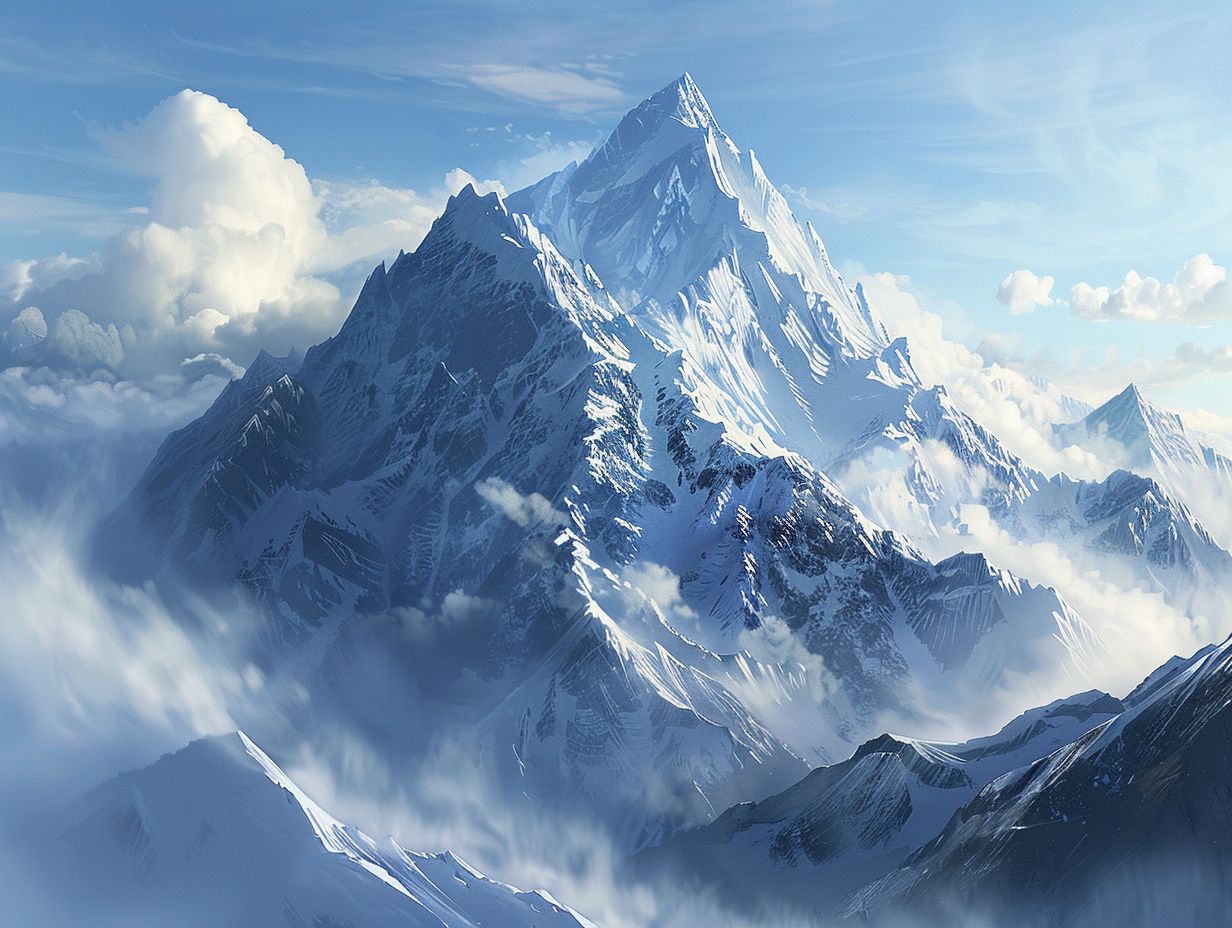
Kilimanjaro Vs Everest
Are you ready to embark on the adventure of a lifetime?
This article will compare two of the world’s most famous mountains: Kilimanjaro and Everest.
We will explore all aspects of these majestic peaks, from their geographical differences to the difficulty levels of climbing.
Join us as we delve into the cost of climbing, the various routes to the summit, the breathtaking scenery and wildlife, and the cultural significance of these iconic mountains.
Get ready to be inspired and awed by the wonders of Kilimanjaro and Everest.
Key Takeaways:

- Kilimanjaro and Everest have significant geographical differences, such as location, height, and topography, leading to distinct climbing experiences.
- The difficulty level of climbing Kilimanjaro and Everest is determined by factors like technical difficulty, altitude, and acclimatization, making each mountain a unique challenge.
- The cost of climbing Kilimanjaro and Everest varies in terms of permits, fees, equipment, and guides, making it essential to budget and plan accordingly for each mountain.
Geographical Differences:
The geographical landscapes of Kilimanjaro and Everest Base Camp offer contrasting experiences for trekkers. Kilimanjaro, located in Tanzania, stands as the highest peak in Africa, while Everest Base Camp in Nepal is known for its towering height in the Himalayas.
Kilimanjaro’s unique topographical features include its dormant volcano, which provides a surreal setting for trekkers to navigate through. The varying altitudes present challenges with acclimatization as climbers ascend through multiple climate zones, from lush rainforests to alpine deserts.
In contrast, Everest Base Camp showcases the rugged terrain of the Himalayas, with steep ascents and precarious paths that test even the most seasoned mountaineers. The cultural aspects also differ, with Kilimanjaro offering encounters with local tribes like the Chagga people, while Everest Base Camp immerses trekkers in Sherpa culture.
Location and Height
Kilimanjaro, situated in Tanzania, is known for its iconic Uhuru Peak, standing at an elevation of 5,895 meters above sea level. On the other hand, Everest Base Camp in Nepal boasts the majestic summit night experience at over 5,360 meters above sea level.
These two iconic landmarks hold a special place in the hearts of adventurous souls worldwide. The peak of Kilimanjaro offers a stunning view of the vast African savannah, while the Everest Base Camp provides a unique opportunity for trekkers to witness the breathtaking Himalayan sunrise.
-
Topography and Climate:
The topography and climate of Kilimanjaro present a unique blend of diverse terrains, ranging from lush rainforests to alpine deserts, while Everest Base Camp’s topography is characterized by challenging rocky paths and icy glaciers.
In terms of acclimatization, trekkers at Kilimanjaro face altitude-related challenges due to the rapid ascent, requiring careful monitoring to prevent altitude sickness. In contrast, those journeying to Everest Base Camp must adjust to extreme cold temperatures, necessitating specialized gear like insulated jackets and boots.
The ecosystems surrounding Kilimanjaro offer encounters with diverse wildlife, including elephants and monkeys in the lower elevations, adding a unique touch to the trekking experience. On the other hand, the journey to Everest Base Camp provides panoramic views of majestic peaks like Lhotse and Nuptse, captivating trekkers with its awe-inspiring beauty.
Difficulty Level:
The difficulty level of trekking to the summits of Kilimanjaro and Everest Base Camp varies significantly due to altitude challenges, physical demands, and acclimatization requirements.
In terms of Kilimanjaro, the highest peak in Africa, reaching 5,895 meters, the main altitude-related challenge lies in dealing with rapid changes in elevation. This can lead to altitude sickness, making proper acclimatization crucial. The physical demands of the climb shouldn’t be underestimated; it requires good cardiovascular endurance and strength.
On the other hand, trekking to Everest Base Camp involves even higher altitudes, reaching a staggering 5,364 meters, presenting a different set of challenges. Oxygen levels decrease significantly, affecting breathing and energy levels, demanding meticulous attention to acclimatization for safe summit success.
-
Technical Difficulty:
Both Kilimanjaro and Everest Base Camp present technical challenges that require prior trekking experience, expertise in high-altitude conditions, and the ability to navigate steep ascents and descents effectively.
During climbs to these iconic peaks, mountaineers often face a myriad of technical difficulties that demand a high level of skill and preparation. The thin air at high altitudes poses a significant challenge, requiring climbers to acclimatize properly to prevent altitude sickness. Trekkers must navigate through varying terrain, from rocky paths to icy slopes, making each step a careful consideration.
Proper training in mountaineering techniques is crucial to safely negotiate the rugged landscapes and unpredictable weather conditions that characterize these treks. An understanding of rope handling, ice axe usage, and glacier travel is essential for a successful ascent and descent.
-
Altitude and Acclimatization:

The altitude at Everest Base Camp poses a significant challenge, requiring trekkers to spend several nights at high elevations to acclimatize properly, enhancing their red blood cell count and seeking advice from a physician.
During acclimatization nights, the body adjusts to the reduced oxygen levels by increasing the production of red blood cells, crucial for carrying oxygen to tissues efficiently. This process, known as erythropoiesis, aids in enhancing oxygen delivery capacity, improving endurance, and reducing the risk of altitude-related illnesses.
Various strategies can be employed to boost red blood cell production naturally, such as maintaining a balanced diet rich in iron and vitamins, staying hydrated, avoiding alcohol and tobacco, and engaging in regular physical activity. These lifestyle choices can support optimal blood oxygenation levels and overall health during high-altitude treks.
Cost of Climbing:
The cost of climbing Kilimanjaro and reaching Everest Base Camp can vary significantly, covering expenses such as permits, fees, essential equipment, and the services of experienced guides.
When considering the financial aspects of embarking on these epic mountain adventures, climbers must be prepared to invest in the necessary permits, which can range from a few hundred to over a thousand dollars depending on the peak and the season.
Along with these permit costs, there are equipment fees to factor in, including high-quality gear for extreme conditions like insulated clothing, crampons, and ice axes, which can add up to substantial amounts.
The value of having a professional guide cannot be overstated, particularly when undertaking the challenging terrain and altitude of these mountains. Guide fees are justified not only for navigation assistance but also for their expertise in safety protocols, emergency response, and ensuring a smoother and more successful ascent.
-
Permits and Fees:
Securing permits for Kilimanjaro, starting at lower elevations, involves distinct fees and regulatory requirements compared to Everest Base Camp, where trekkers begin their journey at higher altitudes.
For Kilimanjaro, climbers typically need to obtain permits through licensed tour operators or trekking companies recognized by the Tanzania National Parks authority. The costs can vary depending on the route chosen and the number of days for the climb. Starting elevations for Kilimanjaro treks are around 1,800 meters, which allows for gradual acclimatization.
In contrast, for Everest Base Camp, permits are arranged through the Nepal Department of Immigration in Kathmandu. The fees are structured based on the specific region within the Everest region that the climbers intend to visit. Trekkers start their journey at a significantly higher elevation of around 2,800 meters, which poses different acclimatization challenges compared to Kilimanjaro.
-
Equipment and Guides:
The essential equipment and experienced guides play a crucial role in ensuring the safety and success of trekkers on the challenging trails of Kilimanjaro and Everest Base Camp, demanding physical fitness and expertise.
When embarking on these expeditions, trekkers must be well-prepared with appropriate gear such as sturdy hiking boots, insulated clothing, and high-altitude trekking equipment. Physical preparedness is paramount due to the rigorous terrain and altitude challenges that these iconic routes present.
Skilled guides, well-versed in the intricacies of the routes, can provide invaluable support by offering guidance on acclimatization, emergency procedures, and ensuring trekkers adhere to necessary safety protocols.
Climbing Routes:
The climbing routes to the summits of Kilimanjaro and Everest Base Camp offer varying levels of difficulty and time requirements, featuring popular trails with unique ascents and descents.
Among these routes, Kilimanjaro presents trekkers with a range of options, such as the Marangu Route known for its simplicity but longer duration or the challenging Machame Route with steeper inclines.
On the other hand, Everest Base Camp boasts trails like the classic Everest Base Camp Trek, usually taking around 12-14 days, with stunning views of iconic Himalayan peaks.
While Kilimanjaro’s ascents involve navigating through diverse landscapes ranging from rainforests to alpine deserts, Everest Base Camp’s path leads through traditional Sherpa villages and high-altitude terrain, both offering distinct cultural experiences for adventurers.
-
Popular Routes:
The Kosovo Camp route on Kilimanjaro and the Barafu Camp route at Everest Base Camp are known for their technical demands and breathtaking landscapes, offering trekkers a challenging yet rewarding experience.
Both Kosovo Camp and Barafu Camp routes present unique challenges that test the physical and mental stamina of trekkers. The Kosovo Camp route on Kilimanjaro is distinguished by its steep ascents and rugged terrains, requiring hikers to navigate through various climate zones.
On the other hand, the Barafu Camp route at Everest Base Camp is renowned for its high altitude and extreme weather conditions, making acclimatization a crucial aspect of the journey.
Despite the differences in geography, both routes offer stunning scenic highlights that captivate adventurers along the way. Kosovo Camp boasts panoramic views of the African savannah below, with glimpses of distant peaks on clear days.
In contrast, Barafu Camp treats trekkers to awe-inspiring vistas of snow-capped Himalayan peaks and vast glaciers, creating a sense of awe and wonder amidst the elements.
-
Time Required for Summit:

The time required to reach the summit of Everest Base Camp typically spans several days, with trekkers often spending nights at high elevations to acclimatize before the final ascent to the breathtaking summit.
These acclimatization nights are crucial as they allow the body to adjust to lower oxygen levels, reducing the risk of altitude-related illnesses. Altitude sickness is a serious concern for climbers due to the extreme elevation.
That’s why guides emphasize the importance of a gradual ascent, giving trekkers time to adapt to the thinning air. Most itineraries include rest days at various camps to aid in the adaptation process, ensuring a safer and more enjoyable journey to the top.
Scenery and Wildlife:
The treks to Kilimanjaro and Everest Base Camp offer mesmerizing views of diverse landscapes, from snow-capped peaks to lush valleys, along with potential encounters with unique wildlife species.
As trekkers ascend Kilimanjaro, they are greeted by the awe-inspiring sight of the legendary snows of Kibo eternally draped across its peak. The journey through various ecological zones on the mountain offers a remarkable opportunity to witness the changing flora and fauna, from heather moorlands to alpine deserts.
In contrast, the trails to Everest Base Camp are dotted with colorful prayer flags fluttering in the wind, leading adventurers through ancient Sherpa villages nestled amid the rugged Himalayan terrain.
-
Views from the Summit:
The panoramic views from Kala Patthar near Everest Base Camp and the scenic beauty of Lukla Bazaar en route offer trekkers unforgettable moments of natural grandeur and cultural immersion.
Standing at an elevation of 5,643 meters, Kala Patthar provides an unparalleled 360-degree view of majestic peaks, including the iconic Mt. Everest. The sunrise from this vantage point is a spectacle that words cannot fully capture, painting the sky in hues of pink and orange.
Contrastingly, Lukla Bazaar, with its bustling markets and traditional Sherpa culture, serves as a bridge between the modern and ancient worlds, offering trekkers a glimpse into the daily lives of the local people.
-
Encounters with Wildlife:
Trekkers at Kilimanjaro and Everest Base Camp may encounter a variety of wildlife species along the trails, adding a touch of adventure and natural beauty to their high-altitude journeys.
As hikers ascend to higher altitudes, the terrain changes, offering diverse opportunities for wildlife sightings. Kilimanjaro’s lower slopes are home to elephants, buffalo, and colobus monkeys, creating a unique safari-like experience along the way.
In contrast, Everest Base Camp’s higher altitudes provide glimpses of elusive snow leopards, Himalayan blue sheep, and Himalayan wolves, showcasing the rugged but captivating wildlife that thrives in this harsh environment.
Cultural Significance:
Beyond their natural beauty, Kilimanjaro and Everest Base Camp hold deep cultural significance, intertwined with the traditions of local communities and the evolving impact of tourism on these iconic destinations.
Exploring the foothills of Kilimanjaro, trekkers can witness the rich cultural heritage of the Chagga people, known for their banana plantations and warm hospitality. On the other hand, the journey to Everest Base Camp provides a glimpse into the spiritual traditions of Sherpas, who have a profound connection with the mountains.
Local interactions along the trails offer trekkers a unique opportunity to engage with diverse communities, supporting local economies while fostering cultural exchange. The influx of tourism has brought both positive changes through increased awareness and preservation efforts, but also challenges in maintaining the delicate balance between cultural authenticity and commercialization.
-
Local Communities and Traditions:
The indigenous communities near Kilimanjaro and the ethnic traditions of Nepal around Everest Base Camp offer trekkers a glimpse into rich cultural tapestries, highlighting the diverse impacts of tourism on these regions.
Community dynamics near Kilimanjaro are deeply rooted in age-old practices of the Maasai and Chagga tribes. These communities uphold intricate ceremonies, folklore passed down through generations, and sustainable agricultural techniques that have sustained them for centuries.
On the other hand, the Sherpa people around Everest Base Camp have a unique cultural heritage woven with Tibetan Buddhism, reflected in colorful monasteries and prayer flags adorning the vibrant landscape.
Despite their distinct traditions, both regions face common challenges and opportunities with the influx of tourism. Local populations have had to navigate the delicate balance between preserving their cultural identity and adapting to accommodate the demands of visitors seeking authentic experiences.
This intersection of tradition and tourism has sparked dialogues on sustainable development and responsible travel practices to ensure the well-being of both the communities and the environment.
-
Impact of Tourism:

The increasing footfall of climbers at Kilimanjaro and Everest Base Camp has posed both challenges and opportunities for the local communities, influencing the natural environment, cultural dynamics, and economic landscapes in these regions.
These iconic destinations, revered for their breathtaking landscapes and unique cultures, have experienced a surge in tourism over the years, attracting adventurers and nature enthusiasts from around the globe.
This influx of visitors has not come without consequences. The fragile ecosystems surrounding Kilimanjaro and Everest Base Camp are facing unprecedented strain, with issues like waste disposal, deforestation, and habitat disruption becoming prevalent.
The traditional ways of life for indigenous communities living in these areas are being altered, sometimes eroding the authenticity of their cultural practices. The commodification of local traditions and artifacts to cater to tourist demands raises concerns about cultural exploitation and identity dilution.
Frequently Asked Questions:
1. What is the difference between Kilimanjaro and Everest?
A: Kilimanjaro is located in Tanzania, Africa, while Everest is located in Nepal, Asia. They are both known as the highest mountains in their respective continents.
2. Which mountain is taller, Kilimanjaro or Everest?
A: Everest is taller, standing at 29,032 feet, while Kilimanjaro has an elevation of 19,341 feet.
3. Which mountain is more difficult to climb, Kilimanjaro or Everest?
A: Everest is considered more technically challenging and requires a higher level of climbing experience and skill. Kilimanjaro, on the other hand, is a non-technical climb that can be completed by anyone with proper preparation and physical fitness.
4. What is the climate like on Kilimanjaro and Everest?
A: Kilimanjaro has a tropical climate, with temperatures ranging from 70-80 degrees Fahrenheit at the base to below freezing at the summit. Meanwhile, Everest has a subarctic climate, with temperatures ranging from -4 to -31 degrees Fahrenheit.
5. Which mountain is more accessible for climbers, Kilimanjaro or Everest?
A: Kilimanjaro is more accessible for climbers as it does not require any specialized equipment or technical climbing skills. However, permits, guides, and proper preparations are still necessary. Everest, on the other hand, requires permits, specialized equipment, and experienced guides to attempt the climb.
6. Which mountain offers a better view, Kilimanjaro or Everest?
A: Both mountains offer stunning views, but the view from Everest’s summit is considered to be more breathtaking due to its location in the Himalayas, with views of other high peaks and valleys. Kilimanjaro offers a unique view of the African landscape and wildlife.